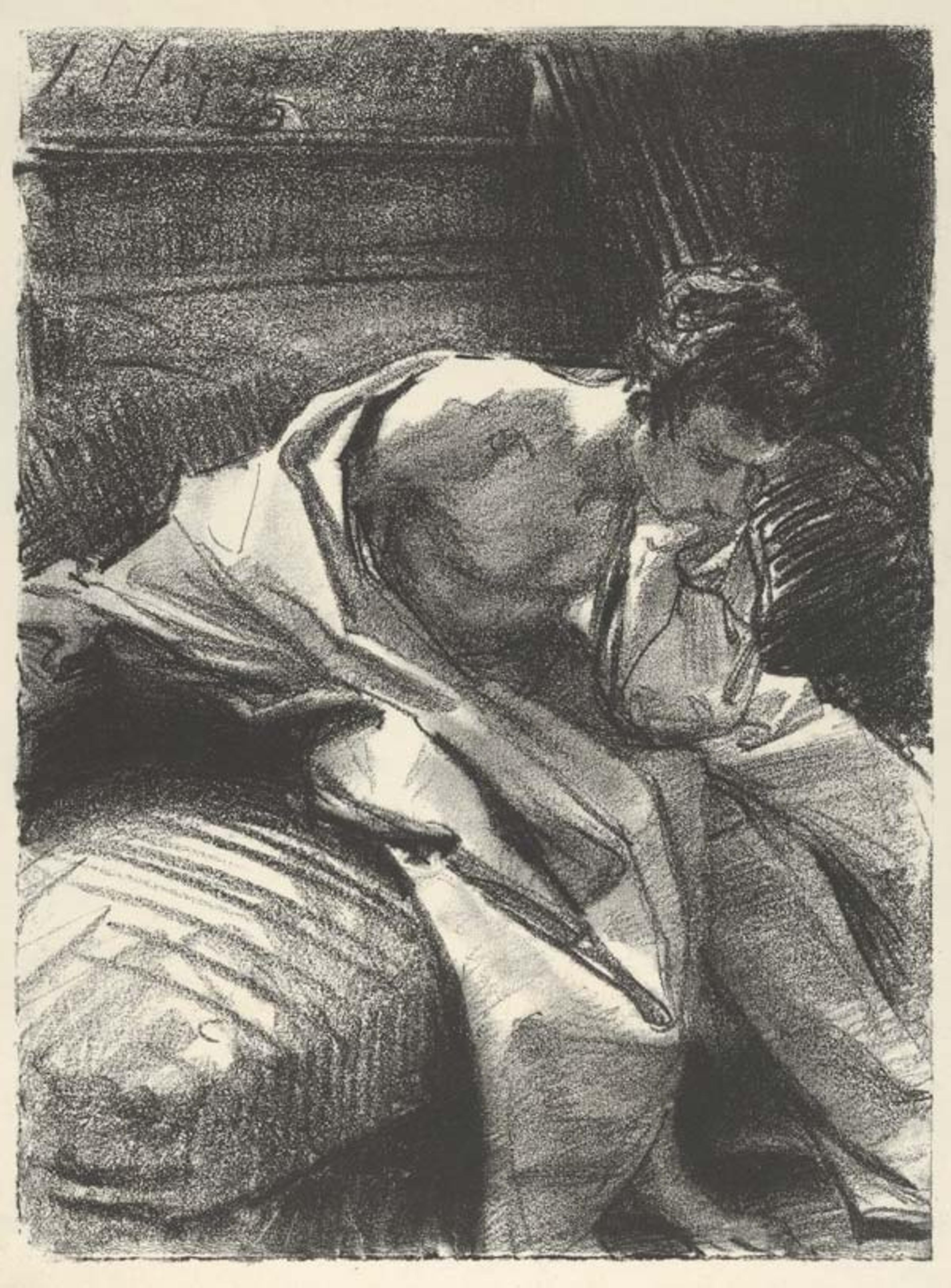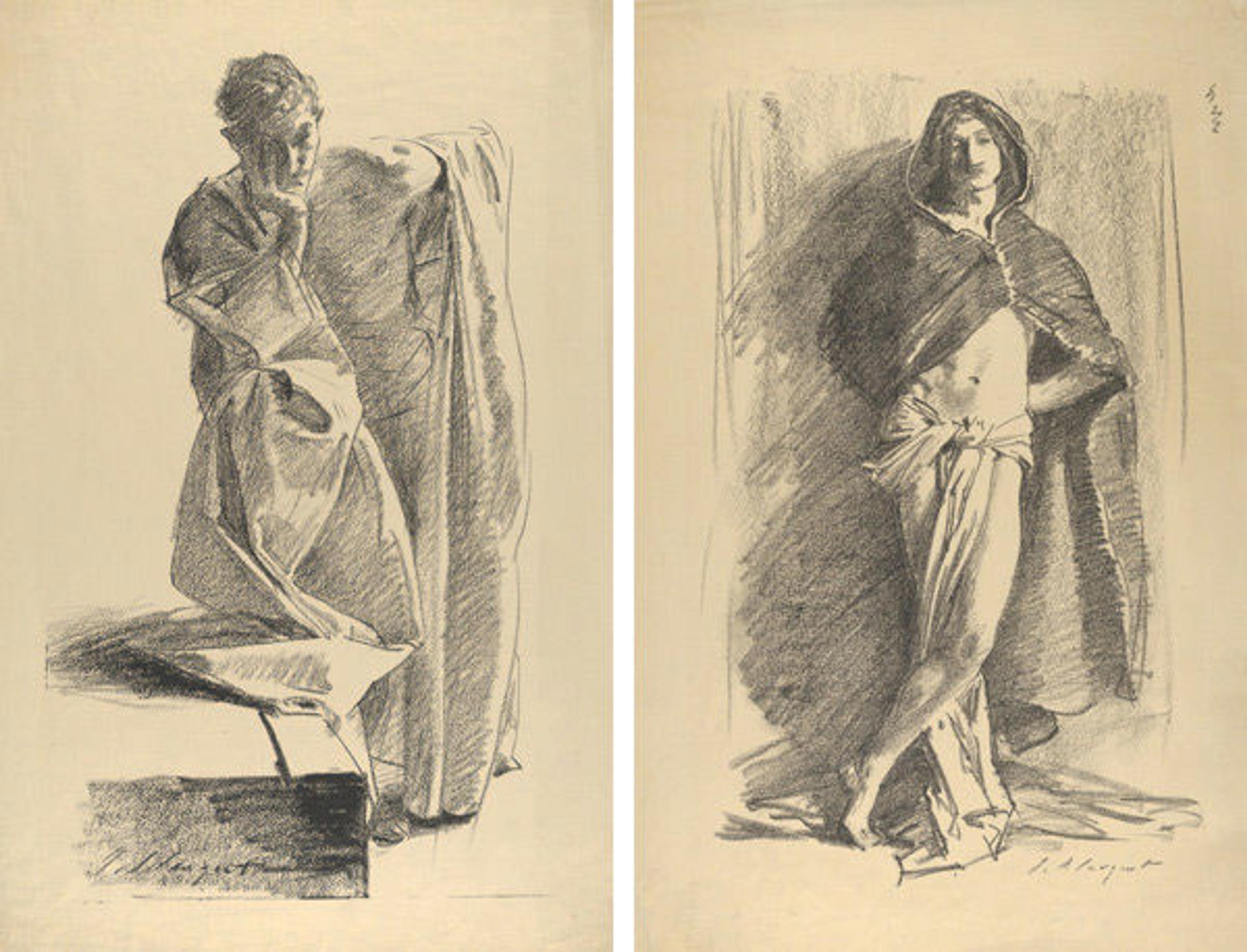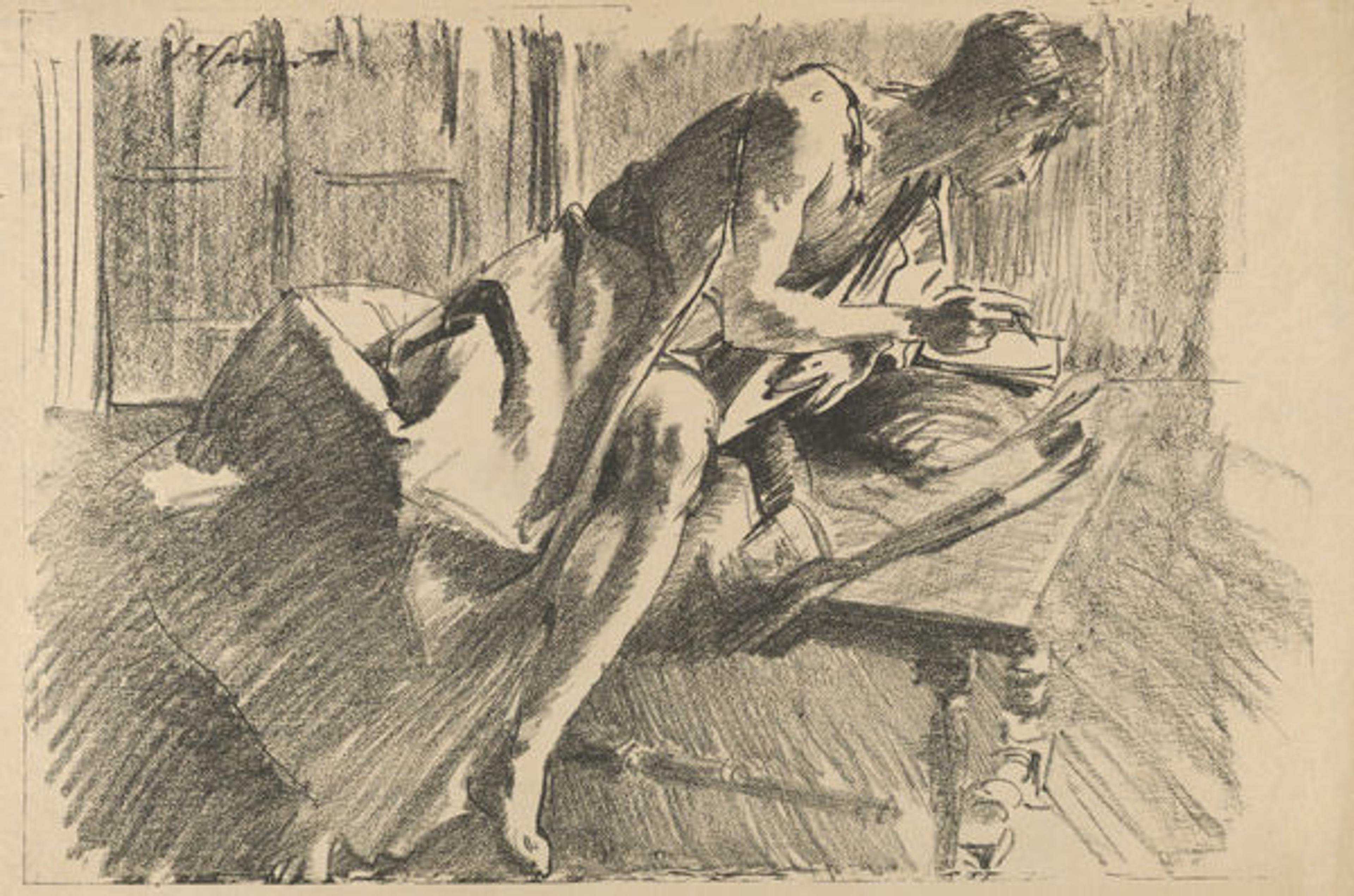Now on View: Lithographs by John Singer Sargent

Fig. 1. John Singer Sargent (American, 1856–1925). Study of a Young Man, Seated, 1895. Transfer lithograph; Image: 11 9/16 x 8 9/16 in. (29.3 x 21.8 cm). The Metropolitan Museum of Art, New York, Gift of Mrs. Francis Ormond, 1950 (50.558.4)
«The Metropolitan Museum's recent exhibition Sargent: Portraits of Artists and Friends featured paintings and watercolors by the celebrated American artist John Singer Sargent. Less well-known is the fact that the artist was also active as a printmaker. In 1895, he made a fascinating group of lithographs as he prepared to send one work to a large overview exhibition, held at the Palais des Beaux Arts in Paris, which celebrated the hundredth anniversary of this particular print medium. Examples of Sargent's experimental lithographs were later donated to the Met, in 1950, by the artist's sister Violet Ormond, and are currently on view in the Robert Wood Johnson, Jr. Gallery.»
The invention of lithography is credited to Alois Senefelder (1771–1834), a German dramatist and musician, who discovered the new method of printing through experiments carried out between 1796 and 1799. Lithography became one of the principal printing techniques of the nineteenth century; accordingly, the Parisian exhibition, held in October 1895, was a huge affair that included both historical and current lithography, scientific, commercial, and artistic displays.
Galerie Rapp organized a section of the exhibition devoted to contemporary artistic prints and asked the British printer Frederick Goulding to help find participants based in London. Artistic lithography had flourished earlier in the nineteenth century, during the days of Daumier, but then largely became the domain of commercial printers. Around 1890, however, new transfer papers sparked renewed artistic interest. Goulding himself invented such a paper and volunteered to supply London artists, Sargent included, with the necessary materials, and then to print their work.
Sargent sent Study of a Young Man, Seated (fig. 1) to be shown in the French exhibition. Using form to define the drama of the work, the striking lithograph shows a young model wrapped in heavy drapery, seated on a striped couch within a shadowy interior. Examples of this print can be found in several museums in America and Britain.

Left: Fig. 2. John Singer Sargent (American, 1856–1925). Study of a Young Man, Seen from the Back, 1895. Transfer lithograph; Sheet: 13 3/4 x 10 1/4 in. (34.9 x 26 cm). The Metropolitan Museum of Art, New York, Gift of Mrs. Francis Ormond, 1950 (50.558.1). Right: Fig. 3. John Singer Sargent (American, 1856–1925). Study of a Young Man, Seen from the Back, 1895. Lithographic crayon on transfer paper; Sheet: 12 5/16 x 9 5/16 in. (31.2 x 23.6 cm). The Metropolitan Museum of Art, New York, Gift of Mrs. Francis Ormond, 1950 (50.558.3)
Study of a Young Man, Seated probably comes latest in the group of lithographs that Sargent made in 1895 as he mastered the medium. His first effort was likely Study of a Young Man, Seen from the Back (figs. 2, 3), its linear design closer in character to his studio drawings of the period. The Met has the original transfer drawing and two copies of the print, and close comparison suggests that the printing may have been complicated, which encouraged the artist to create compositions that were more tonal.

Left: Fig. 4. John Singer Sargent (American, 1856–1925). Study of a Young Man in a Robe, Standing, 1895. Transfer lithograph; Sheet: 19 7/16 x 12 5/8 in. (49.4 x 32 cm). The Metropolitan Museum of Art, New York, Gift of Mrs. Francis Ormond, 1950 (50.558.11). Right: Fig. 5. John Singer Sargent (American, 1856–1925). Study of a Young Man in a Cloak, Standing, 1895. Transfer lithograph; Sheet: 19 1/2 x 12 1/2 in. (49.5 x 31.8 cm). The Metropolitan Museum of Art, New York, Gift of Mrs. Francis Ormond, 1950 (50.558.7)
Study of a Young Man in a Robe, Standing (fig. 4) and Study of a Young Man in a Cloak, Standing (fig. 5) probably came next—with each centered on a standing male figure and much attention given to the fall of light across fabric. These prints also record the face of the model, who has been identified as Nicola d'Inverno, a Londoner of Italian descent who served as Sargent's valet. The Met's impressions of these two prints, and that of the figure seen from the back, seem to be the only copies to survive today.

Fig. 6. John Singer Sargent (American, 1856–1925). Study of a Young Man, Drawing, 1895. Transfer lithograph; Sheet: 12 5/8 x 19 5/8 in. (32.1 x 49.9 cm). The Metropolitan Museum of Art, New York, Gift of Mrs. Francis Ormond, 1950 (50.558.8)
If we can assume that the artist produced increasingly tonal images, Study of a Young Man, Drawing (fig. 6), a copy of which is in the collection of the British Museum, would have been made just before the print he chose to send to Paris. Both include a semirecumbent pose and a developed background, although in Study of a Young Man, Seated, Sargent deepened the shadows significantly and used bright highlights to define the form, a visual process that echoes his technique as a watercolorist.

Fig. 7. John Singer Sargent (American, 1856–1925). Study of a Young Man, Seated, ca. 1895. Transfer lithograph, reworked in the stone; Image: 11 9/16 x 8 9/16 in. (29.3 x 21.8 cm). The Metropolitan Museum of Art, New York, Harris Brisbane Dick Fund, 1946 (46.124)
As a coda to his lithographic experiments, Sargent decided to work directly on the lithographic stone. He created a second version of Study of a Young Man, Seated (fig. 7) by applying patches of lithographic tuche—a special oily ink—blotting out portions of the background, and then scratching highlights across the figure and architecture to transform his original design into a strikingly abstract pattern of darks and lights. In later years the artist used transfer lithography to make several portraits, but the 1895 group stands alone in his career as a fascinating exploration of the medium.
Related Links
Drawings and Prints: Selections from the Permanent Collection, on view September 29, 2015–January 4, 2016
Read more about John Singer Sargent on the Sargent: Portraits of Artists and Friends exhibition blog.
Constance McPhee
Curator Constance C. McPhee is responsible for British drawings, prints, and illustrated books before 1900, and pre-twentieth-century American prints, illustrations, and books. After joining the department as print room supervisor in 2000, she organized the New York venue of Samuel Palmer (1805–1881): Vision and Landscape (2005) and co-curated Infinite Jest: Caricature and Satire from Leonardo to Levine (2011–12) and The Pre-Raphaelite Legacy: British Art and Design (2014). Constance received her BA from Princeton University and an MA and PhD from the University of Pennsylvania.